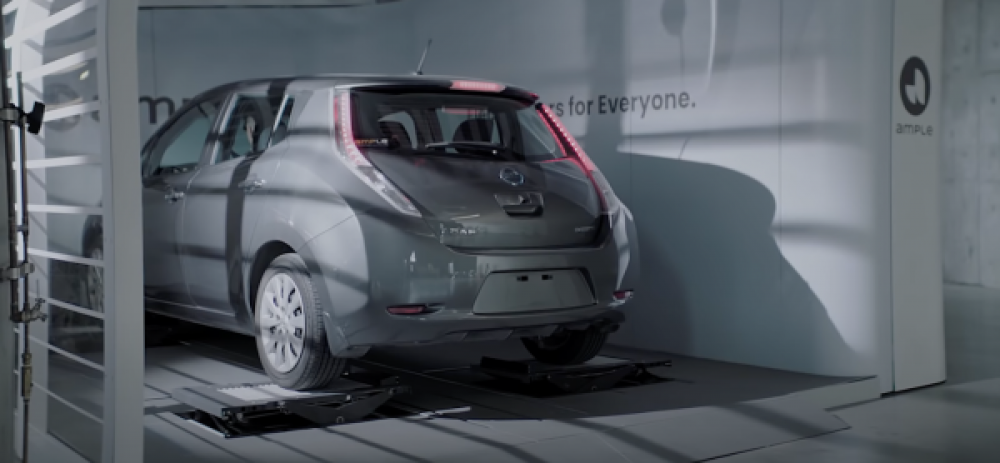
EV Battery Swapping Startup Ample Charges Up Operations In Japan, NYC
EV battery swapping startup Ample charges up operations in Japan, NYC
Ample, an electric vehicle battery swapping startup, announced two partnerships this month that will help fund its expansion into Japan and New York City after years of development. The startup, which was founded in 2014 and emerged from stealth mode in March, announced Tuesday a partnership with Japanese oil and gas company Eneos to jointly deploy and operate battery swapping infrastructure in Japan.
The two companies will pilot Ample's fully automated swapping technology over the next year, with a particular emphasis on ride-hailing, taxi, municipal, rental, and last-mile delivery companies. Ample and Eneos will also assess whether swapping stations can serve additional purposes, such as serving as a backup power source for the energy grid. The partnership is still in its infancy, and few details have been disclosed; Ample, for example, did not disclose when the pilot program would begin or where it would initially launch in Japan. Even with these scant details, Eneos' interest indicates that battery swapping is gaining traction — at least for Ample.
The Eneos announcement comes just days after Ample announced a separate partnership with Sally, a New York City-based electric vehicle rental company that specializes in ride-hailing, taxi, and last-mile delivery. According to Khaled Hassounah, founder and CEO of Ample, the companies will open five to ten stations in New York City by the fourth quarter of this year, with plans to expand into additional markets in 2021.
The partnership between Ample and Sally will also expand to San Francisco in the coming months. Depending on the cost of using both services, this could be a win-win situation for ride-hailing drivers in California, where the state recently mandated that 90 percent of Uber and Lyft drivers drive electric vehicles by 2030.
The Goal of Ample
The goal, Hassounah explained to TechCrunch, is to eventually make swapping stations as ubiquitous as gas stations.
Ample emerged from stealth mode in March with five operational stations in the San Francisco Bay Area and a partnership with Uber in which drivers can rent vehicles directly from Ample that have been retrofitted with the startup's battery technology.
According to Levi Tillemann, Ample's vice president of policy and international outreach, "the Ample architecture is designed to be integrated into any modern electric vehicle." “Unlike with a standard electric vehicle, where the battery pack is never intended to be removed from the vehicle, with the Ample system, the battery pack is replaced with an adapter plate that is virtually identical in size to the OEM-designed battery pack. That adapter plate serves as the architecture for battery swapping.”
According to Tillemann, Ample's standardized battery modules work with any vehicle configured to run on the Ample platform. Ample's partnership with Sally marks the company's transition away from operating its own fleet, which it used to demonstrate its business model. In the future, the company will collaborate with Sally and, most likely, other fleet and rental companies to enable Ample-enabled vehicles.
“Ample's battery swapping technology works with any electric vehicle and significantly reduces the cost and time required to install EV infrastructure because it is a drop-in replacement for the OEM battery that requires no modification to the car's hardware or software,” Hassounah explained.
One of the concerns that prevent ride-hailing drivers from switching to EVs is the time required to charge the battery. According to Hassounah, swapping a battery takes about ten minutes, but the company hopes to reduce that time to five minutes by the end of the year. Having a more streamlined and efficient process may entice ride-hailing drivers and logistics companies to switch.
“At the moment, drivers pay ten cents per mile for swapping services, including energy, and range varies according to vehicle model and battery size,” Hassounah explained. “The cost of the service varies according to the cost of electricity, but our goal is to keep it 10% to 20% less expensive than gas.”
When drivers need to swap a battery, they'll use Ample's app to locate nearby charging stations and then initiate the autonomous swap. Each station can currently accommodate approximately five to six cars per hour, but the company expects to double that capacity by the end of the year. Having said that, this also depends on the amount of power available at a given location.
According to Tillemann, as Ample grows, the company hopes to collaborate with existing OEM partners to offer consumers the option of having Ample production plates installed on their new vehicles as they roll off the assembly line.
“Our unit costs are extremely competitive for battery swap systems,” he explained. “They are inexpensive to deploy, which means that with a small fleet of vehicles, our battery swap architecture is both economical and profitable.”
According to the company, Eneos, which previously invested in Ample, is committed to providing the next generation of energy supply. Additionally, the company is experimenting with hydrogen and recently partnered with Toyota's Woven City, a futuristic prototype city currently under construction in Japan, to power the metropolis with hydrogen.
Courses and Certification
Basic Electronics Course and Certificate
Basic Electricals Course and Certificate
Electrical Safety Course and Certificate
Electronic Circuits Course and Certificate
Electronic Measuring Instruments Course and Certificate

